We have been able to know it in a static presentation
It is a five-seater of 4.83 meters long and a wheelbase of 2.9 meters. Based on the Genesis platform -the premium brand of the group- it will be offered with three engines in the European market. In gasoline will be available between the 2.0 L4 Turbo (Theta II) with 255 hp and 3.3 V6 Biturbo (Lambda II) with 370 hp. The most rational option for many will be the 200 hp 2.2 Diesel, which is an evolution of the same engine available for the Sorento. Depending on the version, it will have rear-wheel drive or all-wheel drive, either as standard or as an option.
This presentation letter is a far cry from other sedans of the brand, such as the Sephia, Shuma or hurrying a lot, the Optima. It is a model that wants to compete directly with the German representatives. The European product communication director, Vladislav Alexiev, commented that its targets are the BMW 4 Series Gran Coupé, Audi A5 Sportback or Infiniti Q50. Of course, it is something they want to do little by little. We can forget about generalist versions, such as the typical 150 hp diesel with 16″ wheels for fleets. The Optima is still below it.
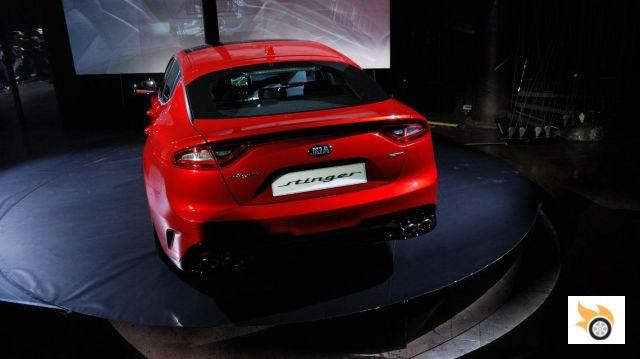
High-end positioning
In order to compete with the premium brands, it's important that the consumer perceives this car as a direct rival, and not a more economical generalist. It's going to be hard for Kia, but I think it's on the right track. Eastern manufacturers, in general, have come up with specific brands for this, like Lexus, Infiniti or Acura. Hyundai has Genesis. Kia goes bareback, it is a brand that has been characterized by offering cars more for ordinary people, at least in Europe, of course.
The brand has taken great care in the quality details in the interior, after having entered the car several times to touch it and feel it all over I have not been able to find anything to criticize (and it is a pre-series). The least good looking detail of the whole car is the badge, but I don't mean that it says "KIA", I mean the finish of the piece itself. The rest of the car is on par, at least in appearance, with premium D-segment sedan-coupe or fastback body styles. What's more, the Stinger is positioned - according to Kia - above models like the Ford Mondeo Vignale by the rear-wheel drive and more premium orientation.
The main European markets for the Stinger will be Germany and the UK.
If there is a downside, I would say it has to do with the construction of the body, mainly in high-strength steels that obviously originate from Hyundai's metallurgical division. It contains no aluminum, magnesium, carbon fiber or other advanced materials. We don't know how much it's going to weigh, but if we're wrong-headed we might conclude that it won't be as light as rivals that do use lighter materials. By the way, the tailgate will not cost anything to lift, it has electric opening and closing.
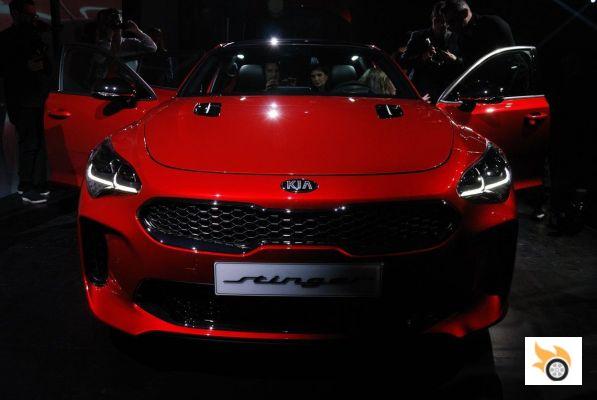
At the presentation, a lot of emphasis was placed on the fact that Kia has a lot of car-loving people at work, who are petrolheads, and they came out posing with various classic models. Well, they say that in practically any brand, I don't know of any brand that promotes itself as an industrial designer of mass-market transportation appliances. They all allude to emotional character, in one way or another.
Certainly with respect to the head of design, Peter Schreyer, nothing to object to. He was responsible for designs like the first-generation Audi TT, and has been on the Koreans' payroll for more than 10 years. What's more, both Hyundai and Kia have made a point of hiring managers who previously worked with premium brands to achieve that something that was missing from their ranges, perhaps we can define it as the concept of "aura" mentioned by the academic Walter Benjamin. The Japanese have already proven they can make cars competitive with the Germans, why shouldn't the Koreans?
The Kia Stinger bet seems very credible to me, and I don't think I'm very suspicious of talking about Kia in a biased or sectarian way. It is certainly a very risky bet, reputable manufacturers such as Renault and Peugeot are having a hard time to have competitive cars in the D segment that can compete with the Teutonic ones. In the E-segment almost all the generalists have thrown in the towel, but that's another story.
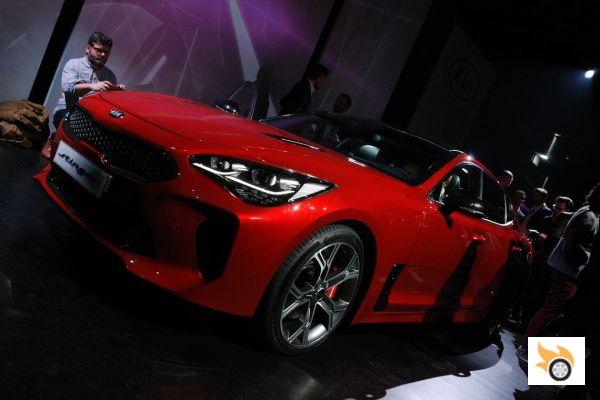
What does the future hold for the Stinger? As Vittorio d'Arienzo, head of product planning and strategy at Hyundai Europe, told us, in the short term the diesel mechanics will receive a nitrogen oxide reduction system using urea (AdBlue) for the Euro 6c phase, and hybrid or electric versions are planned if they see demand for them. Moreover, if there is demand for a family version (it could be a shooting brake) Kia does not rule it out. At the moment these future models have no expected arrival date.
We do not know yet in what price range will move, but it is not unreasonable to think in the 40,000 euros upwards. To give us an idea, the BMW 420d Gran Coupé starts at 43,700 euros and the Audi A5 Sportback 2.0 TDI at 43,300 euros. Knowing Kia's policy, the 200 hp diesel will be around, surely with more equipment than the "basic" models of German brands. Models like the Alfa Romeo Giulia or the Ford Mondeo Vignale already use this strategy: more for the same, or more for less, depending on the version.
I think it's a mistake to think of the Kia Stinger as just another reasonably priced car. Yes, it will come very well equipped and for the same money it will give more things than a BMW, an Audi or a Mercedes, but it won't be economical. If the Kia Optima GT is almost almost at the 40,000 euro level, the Stinger won't be below that. As for the "pata negra", the V6, I won't be shocked if it goes over 50,000 euros. "Who the hell is going to spend 50,000 euros on a Kia?" more than one will say... well, we'll see. In the US there are versions of the K900 (K9 or Quoris) that go over $50,000.
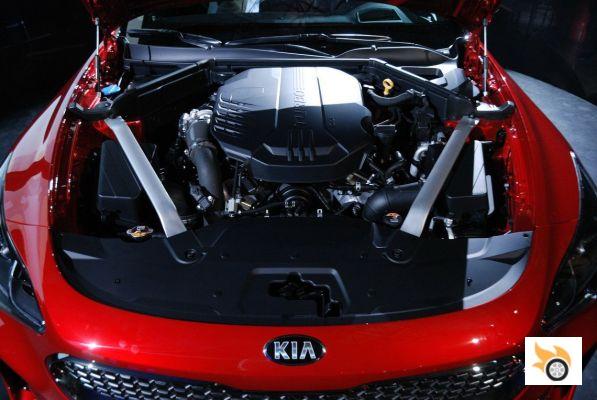
| Engine | Power | Peak Torque | Acceleration 0-100 km/h | Top speed |
|---|---|---|---|---|
| 2.0 Turbo | 255 HP @ 6,200 RPM | 353 Nm @ 1.400-4.000 rpm | N/A | N/A |
| 2.2 Diesel | 200 HP @ 3,800 RPM | 440 Nm @ 1,750-2,750 rpm | 8,5 s | 225 km/h |
| 3.3 V6 Biturbo | 370 HP @ 6,000 RPM | 510 Nm @ 1,300-4,500 rpm | 5,1 s | 270 km/h |
Some technical details
The Kia Stinger's entire engine range is based on turbocharged engines, two four-cylinders and a V6. We had already seen Kia engines over 200 hp, but going over 300 is a different story. Ten years ago there was the Kia Opirus 3.5 V6, with an output of 203 horsepower. Times have changed a lot. Of course the V6 looks like a real lock for loudmouths and barroom opinionated people.
Rear-wheel drive cars can have a self-locking rear differential. With all-wheel drive the distribution is more rear than front, and it has an electronic differential (via brakes). The fully independent suspension features electronically controlled Dynamic Stability Damping Control (DSDC) damping. Like its premium rivals, it allows the suspension to be adapted to suit the driving conditions or the driver's choice of five possible programs: Eco, Sport, Sport+, Comfort and Smart.
To have a power steering to match the circumstances, a variable assistance steering with motor on the rack (R-MDPS) has been adopted, instead of placing it on the column itself. According to Kia, it gives a more direct response and vibrations on the steering wheel are reduced. Depending on the driving mode, the steering feel and hardness changes.
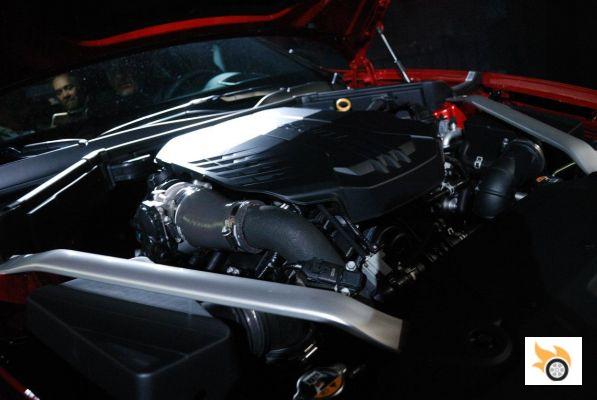
We don't know what the weather is like at the Nürburgring, but it seems that the chassis has been suitably tuned to properly digest that power, it's not like a V8 boat they like in Trumplandia. For example, the GT's brakes are Brembo ventilated discs, with 350mm up front and four-piston calipers, and 340mm at the rear with two-piston calipers. The 2.0 Turbo and 2.2 Diesel have more modest brakes, but do not go below 315 mm in diameter.
In any case mount a torque converter automatic gearbox eight-speed, an internal development of the South Koreans that is not shared with other manufacturers. In order to reduce vibrations, it has a centrifugal pendulum. The driver can choose from five driving modes that alter the behavior of the box. The semi-automatic mode can be enjoyed with the paddle shifters behind the steering wheel.

Bold design
On the outside the design is very striking, it is a car that attracts attention and not only did it do so at the Milan show, it will also do so on the street. The unit on display is a Kia Stinger GT, the one with the more aggressive look, bigger wheels and bigger brakes. The air intakes on the bonnet and the outlets behind the rear wheels are just ornaments, but the air intakes for the brakes and the four exhausts are functional. The diesel will have twin tailpipes on one side, the petrol will have four pipes.
It has elements to improve aerodynamics, such as a smooth underbody or the rear diffuser. The top speed of the Stinger is estimated at 270 km / h, which is above the gentlemen's agreement in the industry by which 250 km / h are more than enough. It's a more relevant figure especially for the Germans, but it has to be said.
Although the fastback roof seems to drop very quickly, the rear seats are comfortable enough for passengers around 1.9 meters tall, with more than enough legroom. Even in this part of the car there is a noticeable effort to do a quality job. We will not break our heads when we get out, just have to be a little careful with the roof. According to Kia, it will be a very pleasant car to travel in. Well, it's looking good...
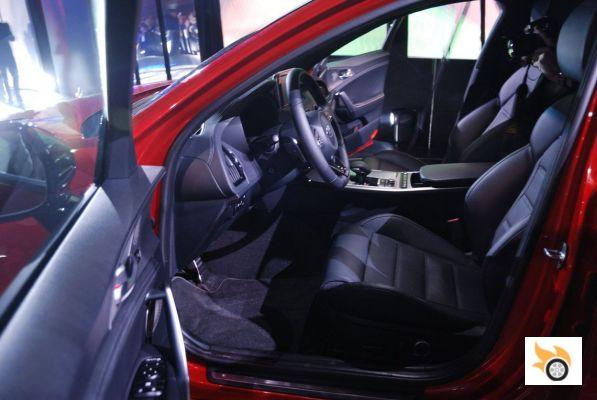
A quick look inside, as it wasn't possible to spend much time inside, given the amount of people that were at the presentation. The soundproofing stands out, in a place where there was so much noise from "blablabla" and electronic music, the decibels dropped considerably when closing all the doors. That could affect the hearing of the engine, but the engineers have thought about that and the sound is naturally reinforced, without resorting to artificial digital sounds through loudspeakers.
The dashboard clearly distinguishes the upper, informational area from the lower one, with a design of three round air vents in the center. Some will say that they have been inspired by Mercedes, I will tell them that Audi also had that kind of design in the A4 range. Officially it has been inspired by the aeronautical world. The central screen is well positioned so as not to distract the driver, plus the Stinger can have information projected via HUD, maximizing driving safety.
All materials look and feel good, even the air vent buttons. They have solidity, qualities worthy of a premium manufacturer. I insist, if we do not get carried away by prejudices, it is a surprising car. The driving position, although I wasn't able to drive it, also points in the right direction. I think it's a car designed by car enthusiasts. Even the instrumentation can report such "trivial" things as oil temperature or G-forces in sporty driving.
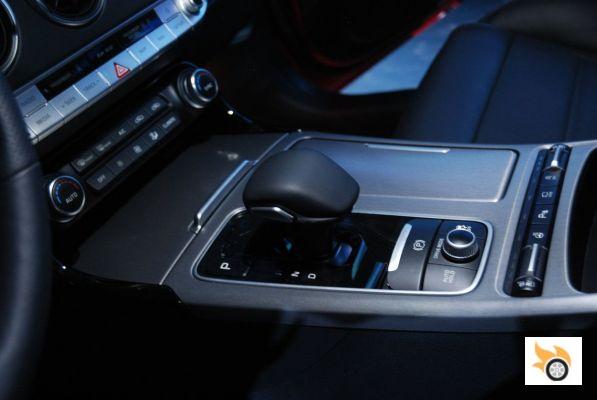
Technology, connectivity and safety
This is a must in a modern car. The press kit doesn't say anything about Android Auto or Apple CarPlay compatibility, but it sounds very attractive to have an optional Harman-Kardon speaker system with 720 watts and 15 speakers (two of them, subwoofers, are under the front seats). The system is the real deal, with digital reconstruction of compressed signals (Clari-Fi™) and QuantumLogic™ Surround Sound. Those who don't need as much can make do with the standard system, with six to nine speakers.
The central touchscreen is 7 to 8 inches, depending on the version, the latter being associated with the top-of-the-range speakers. Its functions haven't been detailed enough to judge, and inside the car I didn't touch anything in that regard. Other interesting interior features include a wireless mobile phone charger, heated/ventilated seats and USB sockets for charging electronic gadgets.
In terms of safety, in addition to the usual airbags, seatbelts... there are the additional systems. Kia cites stability control, autonomous emergency braking for vehicles or pedestrians, front radar cruise control, blind spot detection, driver fatigue detector, dynamic high beam assistant, lane keep assist and rear cross traffic alert. In this respect, it doesn't stand out, it's within the norm for the league it wants to play in.
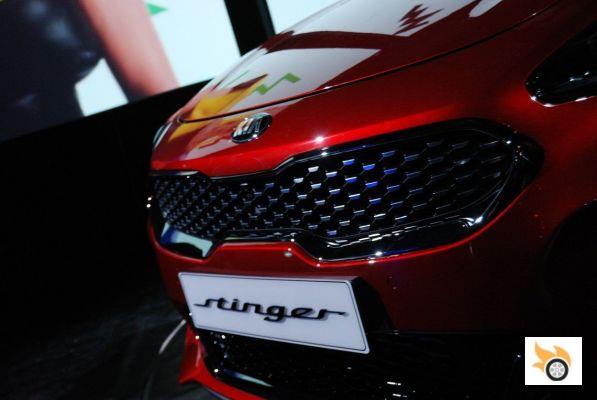
It will go on sale in September/October 2017. Officially, no reservation system has been opened yet, so those interested will have to wait a bit. What's more, several specifications are pending homologation, such as fuel consumption or performance. In other words, it is not completely finished yet.

























